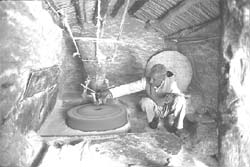Shock treatment
 In India, the Central Electricity Act, 1948, does not allow individuals, communities or cooperatives to take up electricity generation and distribution. Only a private company bound to sell power to the government can do so. Of course the company has to sell power at rates the government fixes. Since such rates are usually subsidies, projects become economically unviable. A joint study of India's rural energy market by the World Bank's Energy Sector Management Assistance Programme and the Winrock International observed: "It becomes clear that the biggest barrier to the commercialisation of renewable energy is political.'
In India, the Central Electricity Act, 1948, does not allow individuals, communities or cooperatives to take up electricity generation and distribution. Only a private company bound to sell power to the government can do so. Of course the company has to sell power at rates the government fixes. Since such rates are usually subsidies, projects become economically unviable. A joint study of India's rural energy market by the World Bank's Energy Sector Management Assistance Programme and the Winrock International observed: "It becomes clear that the biggest barrier to the commercialisation of renewable energy is political.'
Ask watermill ( gharat) owners in Uttaranchal, a solid body of more than 70,000, each a potential electricity producer. Convinced that the government grid could not reach them, they have been demanding that the gharats be upgraded and allowed to generate electricity for local use. "Our basic and primary need is lighting at night. And it is more important for the schoolchildren,' they say. In up 's Chamoli district where the Chipko movement started, electricity is the last thing that the local residents can dream about. This, despite the national grid's omnipresent pylons. For months residents go without electricity and life comes to a halt in the evening. In Uttaranchal about 3,000 villages are yet to be electrified. Ironically, these are the villages with maximum hydropower potential. "Two small hydropower stations near our village are not functioning for the past five years,' says Jayanti Prasad Matiyal, a resident of Gadora village in Chamoli and also the secretary of Chamoli Watermill Owners Association, formed to fight for rights to electricity generation through the gharats . Similar stories abound in India's 10 Himalayan states that have 70 per cent of India's total hydropower potential. Though the potential of small hydro projects is estimated at 10,000 mw, only 210 mw has been tapped till now through 267 projects.
Grim scenario
Rural electrification in India is a state subject and comes under the jurisdiction of state electricity boards. But the nodal agency is the Rural Electrification Corporation ( rec ) which implements national programmes through the state boards. By 1995, more than 85 per cent of the 580,000 villages were electrified. Even then, only 30 per cent of households can access electricity.
There is desperation for electricity in rural areas and villagers are ready to pay for it, says Anil Joshi of the Himalayan Environmental Studies and Conservation Organisation ( hesco ), a Dehradun-based ngo . Highly centralised and heavily subsidised, conventional generation makes electrifying hill villages difficult. Centrally generated power may be cheaper, but transmission and distribution to these remote areas pushes up costs. Enter subsidies to maintain a low tariff: for the state electricity boards, a financial crunch. Chances of these remote villages getting connected to gridlines appear to be bleak.
Government subsidies on conventional (non-renewable) source of electricity makes renewable electricity sources unviable. The share of hydelpower in the total installed capacity in India has been declining in successive plans. In 1967-68, hydro projects had a 46 per cent share in the total installed capacity, which has already declined to 24 per cent in 1998. Only one-third electric supply is consumed in the rural areas, despite the fact that three-fourth of total population is living in rural areas.
"A decentralised power generation is the best thing to happen,' admits Praveen Saxena, director, ministry of non-conventional energy sources ( mnes). This ministry is the nodal agency to implement small hydro-power projects. Since mnes has a mandate to manage hydro projects for up to 25 mw requiring investments of Rs 10-20 million per project, the government has focussed on private commercial participation. The government of India declared a
Related Content
- When water becomes a hazard: a diagnostic report on the state of water supply, sanitation and poverty in Pakistan and its impact on child stunting
- India’s electric turnaround: Powerless to power-surplus
- Green economy scoping study for Jamaica
- GR issued in Nov but not sent to MPCB, VIDC
- Malnutrition is rampant among rural TB patients
- Shocking number of HIV cases detected at blood banks go without follow-up
